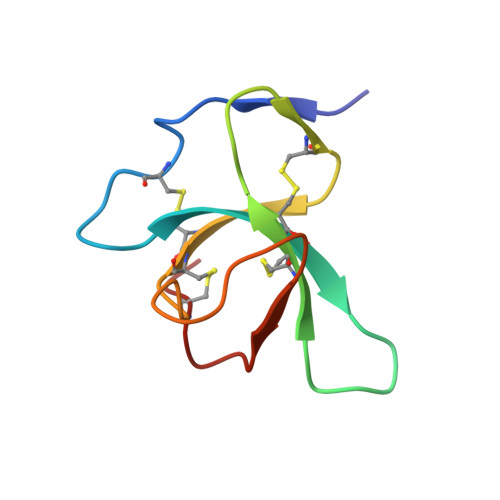The Cys3-Cys4 loop of the hydrophobin EAS is not required for rodlet formation and surface activity.
Kwan, A.H., Macindoe, I., Vukasin, P.V., Morris, V.K., Kass, I., Gupte, R., Mark, A.E., Templeton, M.D., Mackay, J.P., Sunde, M.(2008) J Mol Biology 382: 708-720
- PubMed: 18674544
- DOI: https://doi.org/10.1016/j.jmb.2008.07.034
- Primary Citation of Related Structures:
2K6A - PubMed Abstract:
Class I hydrophobins are fungal proteins that self-assemble into robust amphipathic rodlet monolayers on the surface of aerial structures such as spores and fruiting bodies. These layers share many structural characteristics with amyloid fibrils and belong to the growing family of functional amyloid-like materials produced by microorganisms. Although the three-dimensional structure of the soluble monomeric form of a class I hydrophobin has been determined, little is known about the molecular structure of the rodlets or their assembly mechanism. Several models have been proposed, some of which suggest that the Cys3-Cys4 loop has a critical role in the initiation of assembly or in the polymeric structure. In order to provide insight into the relationship between hydrophobin sequence and rodlet assembly, we investigated the role of the Cys3-Cys4 loop in EAS, a class I hydrophobin from Neurospora crassa. Remarkably, deletion of up to 15 residues from this 25-residue loop does not impair rodlet formation or reduce the surface activity of the protein, and the physicochemical properties of rodlets formed by this mutant are indistinguishable from those of its full-length counterpart. In addition, the core structure of the truncation mutant is essentially unchanged. Molecular dynamics simulations carried out on the full-length protein and this truncation mutant binding to an air-water interface show that, although it is hydrophobic, the loop does not play a role in positioning the protein at the surface. These results demonstrate that the Cys3-Cys4 loop does not have an integral role in the formation or structure of the rodlets and that the major determinant of the unique properties of these proteins is the amphipathic core structure, which is likely to be preserved in all hydrophobins despite the high degree of sequence variation across the family.
- School of Molecular and Microbial Biosciences, University of Sydney, Sydney, New South Wales 2006, Australia.
Organizational Affiliation:
















